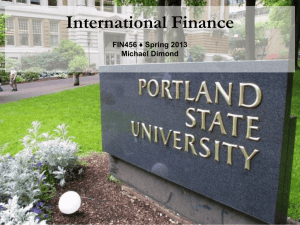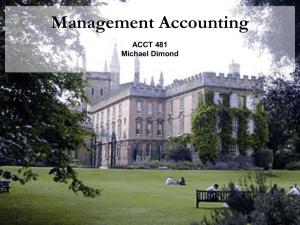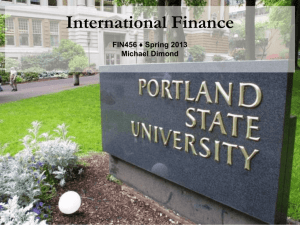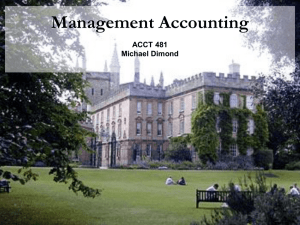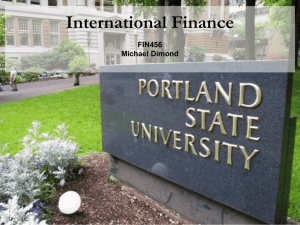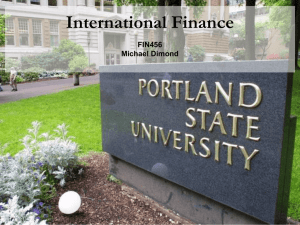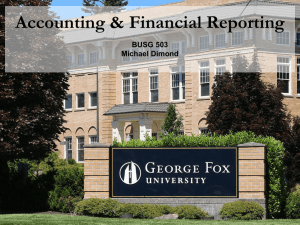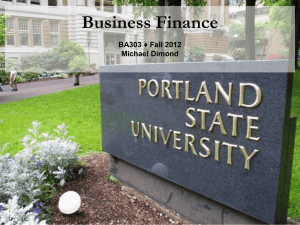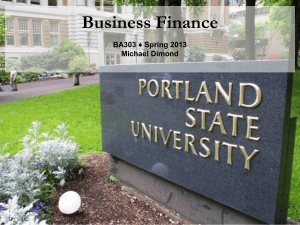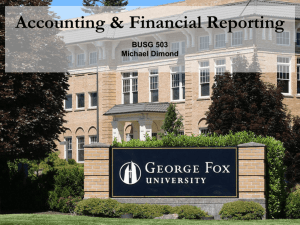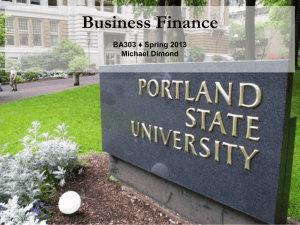Sustaining & Transferring Competitive Advantage
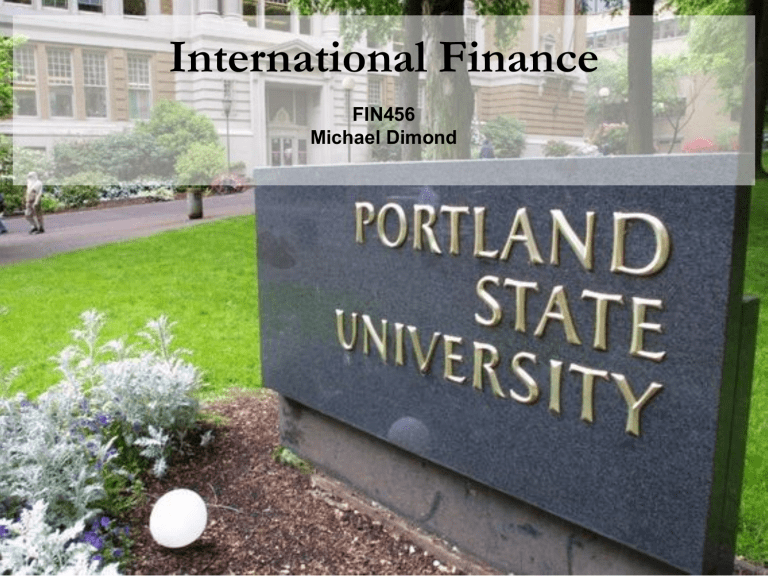
International Finance
FIN456
Michael Dimond
Sustaining & transferring Competitive Advantage
• In deciding whether to invest abroad, management must first determine whether the firm has a sustainable competitive advantage that enables it to compete effectively in the home market
• In order to sustain a competitive advantage it must be:
• Firm-specific
• Transferable
• Powerful enough to compensate the firm for the extra difficulties of operating abroad
• Some of the competitive advantages enjoyed by MNCs are:
• Economies of scale and scope
• Managerial and marketing expertise
• Advanced technology
• Financial strength
• Differentiated products
• Competitiveness of the their home market
Michael Dimond
School of Business Administration
Sustaining & Transferring Competitive Advantage
Michael Dimond
School of Business Administration
Multinational Investment Decisions
• Two related behavioral theories behind FDI that are most popular are
• Behavioral approach to FDI
• International network theory
• Behavioral Approach – Observation that firms tended to invest first in countries that were not too far from their country in psychic terms
• This included cultural, legal, and institutional environments similar to their own
• International network theory – As MNCs grow they eventually become a network, or nodes that operate either in a centralized hierarchy or a decentralized one
• Each subsidiary competes for funds from the parent
• It is also a member of an international network based on its industry
• The firm becomes a transnational firm, one that is owned by a coalition of investors located in different countries
Michael Dimond
School of Business Administration
Alternative investments for expansion
• Exporting vs. production abroad
• Licensing/management contracts versus control of assets abroad
• Joint ventures versus wholly owned subsidiary
• Greenfield investment versus acquisition
• A greenfield investment is establishing a facility “starting from the ground up”
• Usually require extended periods of physical construction and organizational development
• Here, a cross-border acquisition may be better because the physical assets already exist, shorter time frame and financing exposure
• However, problems with integration, paying too much for acquisition, post-merger management, and realization of synergies all exist
Michael Dimond
School of Business Administration
Michael Dimond
School of Business Administration
When making FDI decisions, cost of capital is key
• There are two alternatives in valuing foreign projects:
• Adjusting the discount rate to accommodate risk
• Adjusting the cash flows to accommodate risk
• Adjusting the discount rate is simpler, but the approach can be over-simplified and lead to poor decisions (& agency cost)
• Adjust with a risk premium
• Adjust with a risk model
Michael Dimond
School of Business Administration
Refresher on WACC
• Corcovado Pharmaceutical’s cost of debt is 7%. The risk-free rate of interest is 3%. The expected return on the market portfolio is 8%. After effective taxes, Corcovado’s effective tax rate is 25%. Its optimal capital structure is 60% debt and
40% equity. If Corcovado’s beta is estimated at 0.8, what is its weighted average cost of capital?
Michael Dimond
School of Business Administration
Refresher on Beta
• You should be familiar with some of this…
• β i
= ρ im
σ i
/ σ m
• β f
= ρ fd
σ f
/ σ d
• β project
= β f
β i
Michael Dimond
School of Business Administration
• Corcovado Pharmaceutical’s cost of debt is 7%. The risk-free rate of interest is 3%. The expected return on the market portfolio is 8%. After effective taxes, Corcovado’s effective tax rate is 25%. Its optimal capital structure is 60% debt and
40% equity. If Corcovado’s beta is estimated at 0.8, what is its weighted average cost of capital?
• Assume the beta of the foreign market vs the domestic market is 1.375. What is the WACC for Corcovado to engage in a project in this foreign economy?
Michael Dimond
School of Business Administration
Budgeting for Foreign Projects
• Like domestic capital budgeting, this focuses on the cash inflows and outflows associated with prospective long-term investment projects
• Capital budgeting follows same framework as domestic budgeting
– Identify initial capital invested or put at risk
– Estimate cash inflows, including a terminal value or salvage value of investment
– Identify appropriate discount rate for PV calculation
– Apply traditional analysis
Michael Dimond
School of Business Administration
FDI Example: Cemex enters Indonesia
• Cementos Mexicanos (Cemex) is considering construction of plant in
Indonesia (Semen Indonesia) as a Greenfield project
• Cemex is listed on both US and Mexican markets but most of its capital is US dollar denominated so evaluation of project is in US dollars
Michael Dimond
School of Business Administration
Cemex enters Indonesia
• Financial assumptions
– Capital Investment – cost to build plant estimated at $150/tonne but
Cemex believes it can build the plant at a cost of $110/tonne
• Assuming exchange rate of Rp10,000/$ and a 20 year life, cost is estimated at Rp22 trillion
• With straight line depreciation on equipment values at Rp17.6 trillion costing 1.76 trillion per year
– Financing – plant would be financed with 50% equity (all from
Cemex) and 50% debt
• Debt is broken down, with Cemex providing 75% and a bank consortium providing the remaining 25%
• Cemex’s WACC (in US dollars) is 11.98%
• For the local project (in rupiah) the WACC is 33.257%
Michael Dimond
School of Business Administration
Investment & Financing of Semen Indonesia
All figures in 000s unless stated otherwise
Michael Dimond
School of Business Administration
Cemex enters Indonesia
• More financial assumptions
– Revenues – sales are based on export and the plant will operate at
40% capacity producing 8 million tonnes per year
• Cement will be sold in export market at $58/tonne
– Costs – cost per ton is estimated at Rp115,000 in 1999 and rising at the rate of inflation (30%) per year
• For export costs, loading costs of $2.00/tonne and shipping costs of
$10/tonne must also be added
Michael Dimond
School of Business Administration
Expected Debt Service & Exchange Gain/Loss
Michael Dimond
School of Business Administration
Pro Forma Income Statement
Michael Dimond
School of Business Administration
Project Viewpoint Capital Budget
• Semen Indonsia’s free cash flows are found by looking at EBITDA and not EBT
• Taxes are calculated based on this amount
• Terminal value is calculated for the continuing value of the plant after year 5
– TV is calculated as a perpetual net operating cash flow after year 5
Michael Dimond
School of Business Administration
Remittance of income to parent (MM rupiah & $)
$1,925 is Cemex’s capital investment, NOT the total capital invested:
$1,100MM equity
+ $825MM Debt
Michael Dimond
School of Business Administration
Parent Viewpoint Capital Budget
• Now cash flows estimates are constructed from parent’s viewpoint
• Cemex must now use it’s cost of capital and not the project’s
• Recall that Cemex’s WACC was 11.98%
• However, Cemex requires an additional yield of 6% for international projects, thus the discount rate will be 17.98%
• This yields an NPV of -$925.6 million (IRR –1.84%) which is unacceptable from the parent’s viewpoint
Michael Dimond
School of Business Administration
Sensitivity Analysis: Project Viewpoint
• Political risk – biggest risk is blocked funds or expropriation
– Analysis should build in these scenarios and answer questions such as how, when, how much, etc.
• Foreign exchange risk
– Analysis should also consider appreciation or depreciation of the US dollar
Michael Dimond
School of Business Administration
Sensitivity Analysis: Parent Viewpoint
• When a foreign project is analyzed from the parent’s point of view, the additional risk that stems from its “foreign” location can be measured in at least two ways;
– Adjusting the discount rates
– Adjusting the cash flows
Michael Dimond
School of Business Administration
Sensitivity Analysis: Parent Viewpoint
• Adjusting discount rates
– The first method is to treat all foreign risk as a single problem, by adjusting the discount rate applicable to foreign projects relative to the rate used for domestic projects to reflect the greater foreign exchange risk, political risk, agency costs, asymmetric information and other uncertainties
– However, adjusting the discount rate applied to a foreign project’s cash flow to reflect these uncertainties does not penalize NPV in proportion either to the actual amount at risk or to possible variations in the nature of that risk over time
• Adjusting cash flows
– In the second method, we incorporate foreign risks in adjustments to forecasted cash flows of the project
– The discount rate for the foreign project is risk-adjusted only for overall business and financial risk, in the same manner as for domestic projects
– It is important to remember that the process of forecasting cash flows is extremely subjective. Document all assumptions.
Michael Dimond
School of Business Administration
Shortcomings of Adjustments
• In many cases, neither adjusting the discount rate nor adjusting cash flows is optimal
• For example, political uncertainties are a threat to the entire investment, not just the annual cash flows
• Apart from anticipated political and foreign exchange risks,
MNCs sometimes worry that taking on foreign projects may increase the firm’s overall cost of capital because of investor’s perceptions of foreign risk; in these cases diversification is a risk mitigant
Michael Dimond
School of Business Administration
Michael Dimond
School of Business Administration
